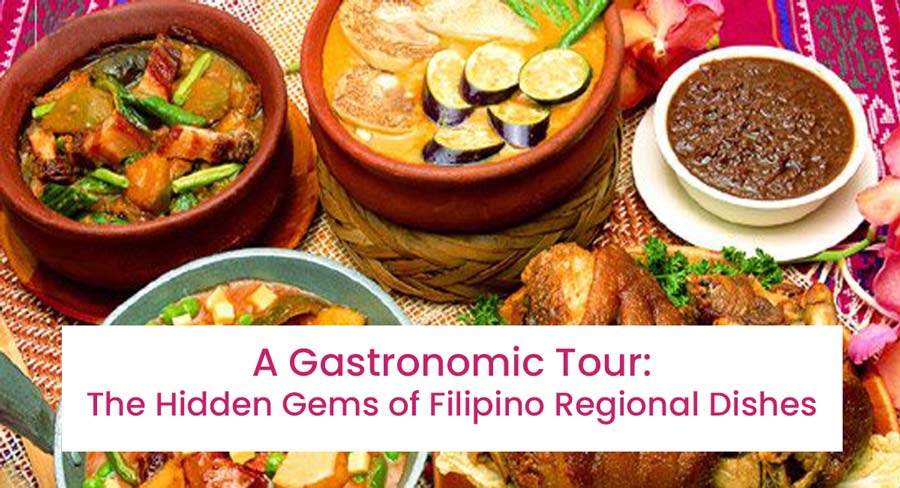
A Gastronomic Tour: The Hidden Gems of Filipino Regional Dishes
Filipino cuisine is a rich tapestry of flavors and influences, with each region in the Philippines having its own unique dishes. These regional dishes are considered hidden gems, as they might not be as well-known internationally as the more popular Filipino dishes like adobo or lechon. However, they are an essential part of the Filipino culinary landscape and offer a diverse range of flavors and ingredients. This article will explore the hidden gems of Filipino regional dishes, their history and evolution, the making of such dishes, where to experience them, the influence they have on global cuisine, and the future of Filipino gastronomy.
History and Evolution of Filipino Regional Dishes
Filipino regional dishes have a rich history that dates back to pre-Colonial times. Each region in the Philippines has its own distinct culinary heritage, influenced by factors such as geography, climate, cultural traditions, and trade routes. Through the years, these regional dishes have evolved, blending indigenous ingredients and techniques with influences from Spanish, Chinese, Malay, and American cuisines.
The Diversity of Filipino Regional Dishes
Luzon's Signature Dishes
Luzon, the largest island in the Philippines, boasts a wide array of signature dishes. In the northern part of Luzon, dishes like pinakbet (a vegetable stew), bagnet (crispy pork belly), and pakbet Ilocano (a variation of pinakbet made with bitter gourd) are popular. In the central part of Luzon, dishes like sisig (grilled pork cheeks and ears) and bringhe (a rice dish similar to paella) are must-tries. Meanwhile, in the southern part of Luzon, dishes like laing (taro leaves cooked in coconut milk) and pili nut delicacies are prominent.
Visayas' Native Delicacies
Visayas, located in the heart of the Philippine archipelago, is known for its native delicacies. In some parts of Visayas, a rice cake called bibingka is popular. In others, there is kakanin or sticky rice desserts like puto, suman, and budbud. Additionally, Visayas is famous for its seafood dishes, such as kinilaw (a raw fish salad), and inasal (grilled chicken marinated in vinegar and spices).
Mindanao's Unique Foods
Mindanao, the southernmost major island in the Philippines, has a diverse culinary culture influenced by the region's ethnic diversity. Dishes like piyanggang (grilled chicken marinated in turmeric and spices) from the Maranao tribe, Joloano-style dishes with Middle Eastern influences, and Tausug delicacies like tiyulah itum (black curry) are just a few examples of the vast array of tastes and flavors found in Mindanao.
The Making of Regional Dishes
Cooking Techniques
The making of regional dishes in the Philippines involves various cooking techniques, such as sautéing, boiling, grilling, and stewing. Some regions have their own unique cooking methods, such as the "inun-unan" or braising technique in some Visayan dishes, or the "pinakbet style" of cooking vegetables in the Ilocos region.
Ingredients
The diversity of Filipino regional dishes is also reflected in the ingredients used. From seafood and tropical fruits to aromatic herbs and spices, each region utilizes local produce that is readily available. Coconut milk, calamansi, shrimp paste, and an assortment of native vegetables and fruits are commonly used ingredients that add depth and flavor to these dishes.
Where to Experience Authentic Regional Dishes
Specialty Restaurants in the City
Cities in the Philippines, particularly the capital Manila, are home to specialty restaurants that showcase regional dishes. These restaurants offer an opportunity for locals and tourists alike to explore the diverse culinary traditions of different regions in one place. It's a great way to savor the flavors of Luzon, Visayas, and Mindanao without having to travel across the country.
Local Eateries in Provinces
For a more authentic experience, exploring local eateries in the provinces is highly recommended. These eateries often serve traditional, home-cooked regional dishes that have been passed down through generations. From small roadside stalls to hole-in-the-wall restaurants, these establishments offer an immersive dining experience that captures the essence of Filipino cuisine.
Highlighting Underrated Regional Dishes
While Filipino cuisine is gaining recognition worldwide, some regional dishes still remain underrated. This is an opportunity to shed light on hidden gems like Kankanen in Ilocos, or Budbud in Cebu, which may not be as well-known as their more popular counterparts. By highlighting these dishes, we can promote the diverse culinary traditions of the Philippines and encourage their inclusion in international menus.
The Influence of Filipino Regional Dishes on Global Cuisine
Filipino regional dishes have started to make an impact on the global culinary scene. From fusion cuisine to Filipino-inspired restaurants, the flavors, techniques, and ingredients of Filipino regional dishes have captivated the taste buds of international food enthusiasts. The unique combination of flavors and the use of indigenous ingredients have inspired chefs around the world to experiment with Filipino cuisine and incorporate it into their own menus.
Filipino regional dishes are the hidden gems of Filipino cuisine, showcasing the rich gastronomic heritage of each region in the Philippines. From Luzon's signature dishes to Visayas' native delicacies and Mindanao's unique foods, these dishes offer a diverse range of flavors and ingredients. The making of these dishes involves various cooking techniques and the use of local produce, bringing out the distinctiveness of each region.
Whether dining in specialty restaurants in the city or exploring local eateries in the provinces, experiencing authentic regional dishes is a must for food enthusiasts. As these dishes gain recognition globally, the future of Filipino gastronomy in the global culinary scene looks promising, preserving and promoting the rich culinary heritage of the Philippines.
